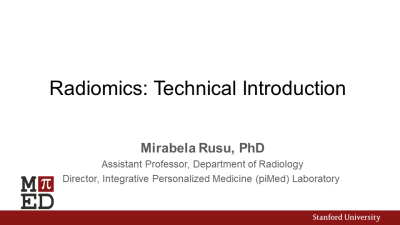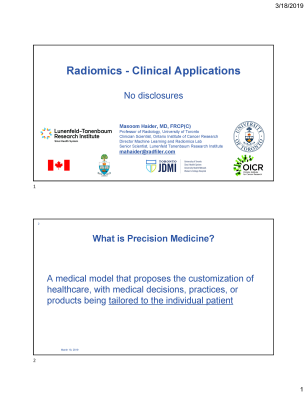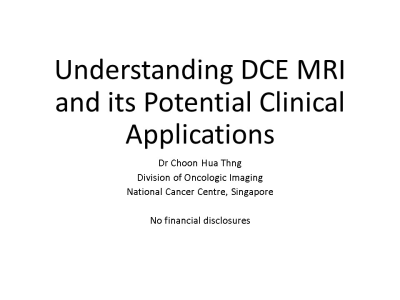Cutting-Edge Techniques in Body MRI
Cutting-Edge Techniques in Body MRI
Weekend Course
Weekend Course
ORGANIZERS: Vikas Gulani, Mustafa Bashir, Utaroh Motosugi
Saturday, 11 May 2019
| Room 518A-C | 08:00 - 11:50 | Moderators: Susan Noworolski, Kinh Gian Do |
Skill Level: Basic to Intermediate
Session Number: WE-03
Overview
The goal of this course is to introduce the audience to cutting-edge technology for quantitative and functional evaluation of tissue. The course is structured in two parts for each topic: an introduction to the technology followed by a clinical talk.
Target Audience
All radiologists and scientists interested in body imaging.
Educational Objectives
As a result of attending this course, participants should be able to:
- Recognize the scientific underpinnings behind methods utilized in deep learning, radiomics, perfusion MRI, fast MRI as applied to body imaging, and new developments in diffusion MRI; and
- Describe clinical applications of deep learning, radiomics, perfusion MRI, fast MRI as applied to body imaging, and diffusion MRI.
Overview
The goal of this course is to introduce the audience to cutting-edge technology for quantitative and functional evaluation of tissue. The course is structured in two parts for each topic: an introduction to the technology followed by a clinical talk.
Target Audience
All radiologists and scientists interested in body imaging.
Educational Objectives
As a result of attending this course, participants should be able to:
- Recognize the scientific underpinnings behind methods utilized in deep learning, radiomics, perfusion MRI, fast MRI as applied to body imaging, and new developments in diffusion MRI; and
- Describe clinical applications of deep learning, radiomics, perfusion MRI, fast MRI as applied to body imaging, and diffusion MRI.
| 08:00 |
Machine Learning & Deep Learning: Technical Introduction
Florian Knoll
This talk will provide an overview of the technical background of machine learning and deep learning in medical imaging. Common hurdles and pitfalls will be discussed via didactic examples from classification and reconstruction. Examples will be provided from a range of MRI applications, with special focus on body imaging.
|
|
| 08:25 |
Machine Learning & Deep Learning: Clinical Applications
Shigeru Kiryu
This talk will introduce the clinical applications of deep learning becoming a reality. It will also discuss the unique aspects of deep learning in clinical applications along with its limitations.
|
|
| 08:50 |
 |
Radiomics: Technical Introduction
Mirabela Rusu
This course is an introduction to Radiomics approaches. The course summarizes the different steps required to pre-process the radiologic images, extract features, reduce the feature sets and the types of analysis that can be performed on these features. Pitfalls of Radiomics analysis are also discussed.
|
| 09:15 |
 |
Radiomics: Clinical Applications
Masoom Haider
Although quantitative imaging biomarkers are used in clinical care, mining of MRI images to derive quantitative signature based on large feature sets (radiomics) as a distinct approach is primarily a research endeavor in 2019. Approaches to have maximal clinical impact should combine knowledge of MRI physics, biologic sciences, computer vision, medicine and health economics
|
| 09:40 |
Break & Meet the Teachers | |
| 10:10 |
Fast Imaging & Perfusion: Technical Introduction
Yong Chen
Fast imaging techniques are crucial for abdominal MRI. This presentation will first cover the basic concepts of parallel imaging techniques and their usage in accelerating abdominal scans. We will further discuss recent advances in fast imaging techniques and how these techniques enable quantitative perfusion measurement in the abdomen.
|
|
| 10:35 |
 |
Understanding DCE MRI & Its Potential Clinical Applications
Choon Thng
Basic mathematical concepts and relationships such as convolution, arterial input function, impulse residue function (IRF), microcirculatory parameters such as flow and permeability, tumor concentration time curve are explained qualitatively to facilitate understanding of tracer kinetic modelling and derivation of microcirculatory parameters by curve fitting. Common DCE MRI parameters such as Ktrans is explained. More complex models are discussed along with their benefits and trade-offs. Unique microcirculatory properties of the liver are explained relating to zero fractional interstitial space in normal liver and a positive value for cirrhosis. Potential clinical applications are briefly discussed.
|
| 11:00 |
Advanced DIffusion Imaging: Technical Introduction
Amita Shukla-Dave
This lecture covers the advancement in the technical development of Diffusion Weighted Imaging (DWI). DWI depends upon the microscopic mobility of water. Water mobility within tissue is highly influenced by the cellular environment, allowing DWI mapping of the diffusion of molecules, mainly water, in biological tissue in vivo and non-invasively. Molecular diffusion in tissues is restricted and reflects interactions with macromolecules, fibers, membranes, etc., revealing details about tissue architecture, which could be either normal or in a diseased state. Thus, DWI has become a non-invasive tool of choice for many clinical applications from assessment of cerebral ischemia to tumor aggressiveness. A series of technical advances, such as developments of echo-planar imaging (EPI), high gradient amplitudes, multi-channel coils, navigator triggered acquisition for motion compensation, and parallel imaging, have been instrumental in extending the application of DWI to the body. However, primary challenges, such as multiple occurrence of motion, persist.
|
|
| 11:25 |
Clinical applications for advanced body diffusion imaging: challenges and opportunities
Dariya Malyarenko
Notwithstanding technological advances in body DWI acquisition and analysis, their clinical applications remain relatively sparse. Quantitative (q)DWI protocols enable evaluation of sophisticated tissue diffusivity models to derive Gaussian and non-Gaussian parameters (ADC, IVIM, kurtosis) and/or texture-based features (histogram moments and gray-level) of high potential relevance to pathology. Clinically viable qDWI metrics should reflect target pathology using practical acquisition protocol and analysis observing relevant biophysical constraints. By reviewing examples of successful qDWI implementations in clinical oncology studies (for prostate, liver, breast, and whole body metastasis), this lecture will highlight venues to balance existing disparities between research and unmet clinical need.
|
|
| 11:50 |
Adjournment & Meet the Teachers |
 Back to Program-at-a-Glance |
Back to Program-at-a-Glance |  Back to Top
Back to Top